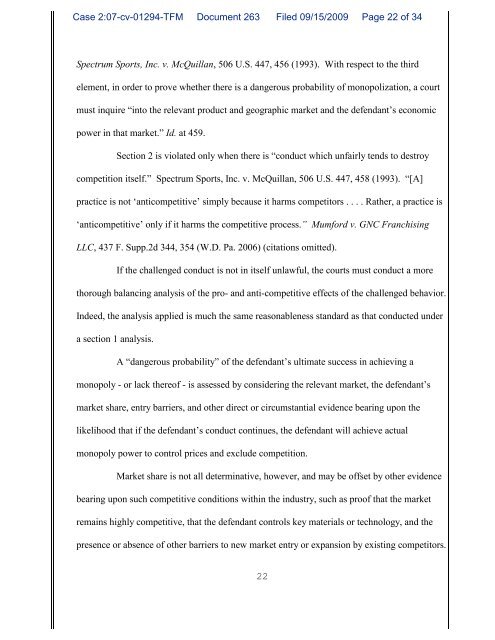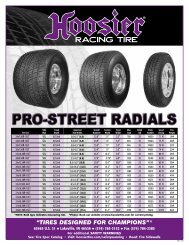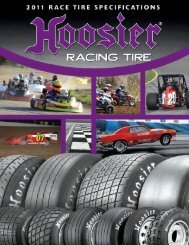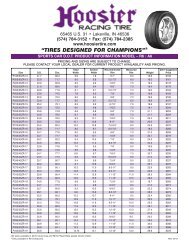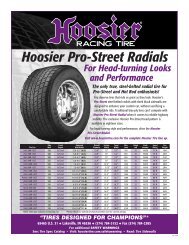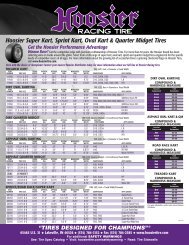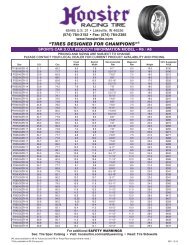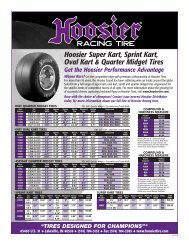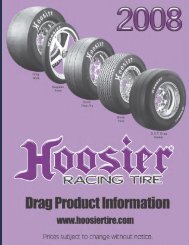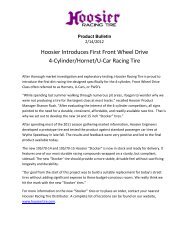in the united states district court for the - Hoosier Racing Tire
in the united states district court for the - Hoosier Racing Tire
in the united states district court for the - Hoosier Racing Tire
You also want an ePaper? Increase the reach of your titles
YUMPU automatically turns print PDFs into web optimized ePapers that Google loves.
Case 2:07-cv-01294-TFM Document 263 Filed 09/15/2009 Page 22 of 34<br />
Spectrum Sports, Inc. v. McQuillan, 506 U.S. 447, 456 (1993). With respect to <strong>the</strong> third<br />
element, <strong>in</strong> order to prove whe<strong>the</strong>r <strong>the</strong>re is a dangerous probability of monopolization, a <strong>court</strong><br />
must <strong>in</strong>quire “<strong>in</strong>to <strong>the</strong> relevant product and geographic market and <strong>the</strong> defendant’s economic<br />
power <strong>in</strong> that market.” Id. at 459.<br />
Section 2 is violated only when <strong>the</strong>re is “conduct which unfairly tends to destroy<br />
competition itself.” Spectrum Sports, Inc. v. McQuillan, 506 U.S. 447, 458 (1993). “[A]<br />
practice is not ‘anticompetitive’ simply because it harms competitors . . . . Ra<strong>the</strong>r, a practice is<br />
‘anticompetitive’ only if it harms <strong>the</strong> competitive process.” Mum<strong>for</strong>d v. GNC Franchis<strong>in</strong>g<br />
LLC, 437 F. Supp.2d 344, 354 (W.D. Pa. 2006) (citations omitted).<br />
If <strong>the</strong> challenged conduct is not <strong>in</strong> itself unlawful, <strong>the</strong> <strong>court</strong>s must conduct a more<br />
thorough balanc<strong>in</strong>g analysis of <strong>the</strong> pro- and anti-competitive effects of <strong>the</strong> challenged behavior.<br />
Indeed, <strong>the</strong> analysis applied is much <strong>the</strong> same reasonableness standard as that conducted under<br />
a section 1 analysis.<br />
A “dangerous probability” of <strong>the</strong> defendant’s ultimate success <strong>in</strong> achiev<strong>in</strong>g a<br />
monopoly - or lack <strong>the</strong>reof - is assessed by consider<strong>in</strong>g <strong>the</strong> relevant market, <strong>the</strong> defendant’s<br />
market share, entry barriers, and o<strong>the</strong>r direct or circumstantial evidence bear<strong>in</strong>g upon <strong>the</strong><br />
likelihood that if <strong>the</strong> defendant’s conduct cont<strong>in</strong>ues, <strong>the</strong> defendant will achieve actual<br />
monopoly power to control prices and exclude competition.<br />
Market share is not all determ<strong>in</strong>ative, however, and may be offset by o<strong>the</strong>r evidence<br />
bear<strong>in</strong>g upon such competitive conditions with<strong>in</strong> <strong>the</strong> <strong>in</strong>dustry, such as proof that <strong>the</strong> market<br />
rema<strong>in</strong>s highly competitive, that <strong>the</strong> defendant controls key materials or technology, and <strong>the</strong><br />
presence or absence of o<strong>the</strong>r barriers to new market entry or expansion by exist<strong>in</strong>g competitors.<br />
22


